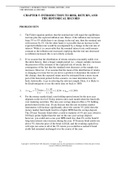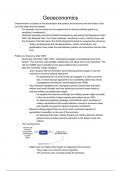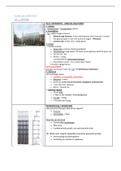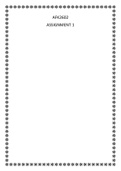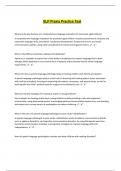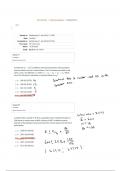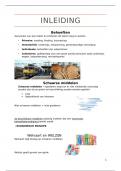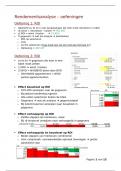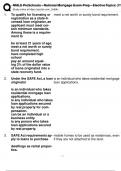CHAPTER 5: INTRODUCTION TO RISK, RETURN, AND
THE HISTORICAL RECORD
CHAPTER 5: INTRODUCTION TO RISK, RETURN, AND
THE HISTORICAL RECORD
PROBLEM SETS
1. The Fisher equation predicts that the nominal rate will equal the equilibrium
real rate plus the expected inflation rate. Hence, if the inflation rate increases
from 3% to 5% while there is no change in the real rate, then the nominal rate
will increase by 2%. On the other hand, it is possible that an increase in the
expected inflation rate would be accompanied by a change in the real rate of
interest. While it is conceivable that the nominal interest rate could remain
constant as the inflation rate increased, implying that the real rate decreased
as inflation increased, this is not a likely scenario.
2. If we assume that the distribution of returns remains reasonably stable over
the entire history, then a longer sample period (i.e., a larger sample) increases
the precision of the estimate of the expected rate of return; this is a
consequence of the fact that the standard error decreases as the sample size
increases. However, if we assume that the mean of the distribution of returns
is changing over time but we are not in a position to determine the nature of
this change, then the expected return must be estimated from a more recent
part of the historical period. In this scenario, we must determine how far
back, historically, to go in selecting the relevant sample. Here, it is likely to
be disadvantageous to use the entire data set back to 1880.
1 + rNominal 1 + .45
3. 1 + rReal = = = 1.1154 → rReal = 11.54%
1+ i 1 + .30
4. For the money market fund, your holding-period return for the next year
depends on the level of 30-day interest rates each month when the fund rolls
over maturing securities. The one-year savings deposit offers a 5% holding
period return for the year. If you forecast that the rate on money market
instruments will increase significantly above the current 3% yield, then the
money market fund might result in a higher HPR than the savings deposit.
The 20-year Treasury bond offers a yield to maturity of 5% per year, which is
100 basis points higher than the rate on the one-year savings deposit;
however, you could earn a one-year HPR much less than 4% on the bond if
long-term interest rates increase during the year. If Treasury bond yields rise
above 5%, then the price of the bond will fall, and the resulting capital loss
will wipe out some or all of the 5% return you would have earned if bond
yields had remained unchanged over the course of the year.
5-1
Copyright © 2020 McGraw-Hill Education. All rights reserved. No reproduction or distribution without the prior written
consent of McGraw-Hill Education.
, CHAPTER 5: INTRODUCTION TO RISK, RETURN, AND
THE HISTORICAL RECORD
5. a. If businesses reduce their capital spending, then they are likely to
decrease their demand for funds. This will shift the demand curve in
Figure 5.1 to the left and reduce the equilibrium real rate of interest.
b. Increased household saving will shift the supply of funds curve to the
right and cause real interest rates to fall.
c. Open market purchases of U.S. Treasury securities by the Federal
Reserve Board are equivalent to an increase in the supply of funds (a
shift of the supply curve to the right). The FED buys treasuries with
cash from its own account or it issues certificates which trade like
cash. As a result, there is an increase in the money supply, and the
equilibrium real rate of interest will fall.
6. a. The “Inflation-Plus” CD is the safer investment because it guarantees the
purchasing power of the investment. Using the approximation that the real
rate equals the nominal rate minus the inflation rate, the CD provides a real
rate of 1.5% regardless of the inflation rate.
b. The expected return depends on the expected rate of inflation over the next
year. If the expected rate of inflation is less than 3.5% then the conventional
CD offers a higher real return than the inflation-plus CD; if the expected rate
of inflation is greater than 3.5%, then the opposite is true.
c. If you expect the rate of inflation to be 3% over the next year, then the
conventional CD offers you an expected real rate of return of 2%, which is
0.5% higher than the real rate on the inflation-protected CD. But unless you
know that inflation will be 3% with certainty, the conventional CD is also
riskier. The question of which is the better investment then depends on your
attitude towards risk versus return. You might choose to diversify and invest
part of your funds in each.
d. No. We cannot assume that the entire difference between the risk-free
nominal rate (on conventional CDs) of 5% and the real risk-free rate (on
inflation-protected CDs) of 1.5% is the expected rate of inflation. Part of the
difference is probably a risk premium associated with the uncertainty
surrounding the real rate of return on the conventional CDs. This implies
that the expected rate of inflation is less than 3.5% per year.
7. E(r) = [0.35 × 44.5%] + [0.30 × 14.0%] + [0.35 × (–16.5%)] = 14%
2 = [0.35 × (44.5 – 14)2] + [0.30 × (14 – 14)2] + [0.35 × (–16.5 – 14)2] = 651.175
= 25.52%
The mean is unchanged, but the standard deviation has increased, as the
probabilities of the high and low returns have increased.
5-2
Copyright © 2020 McGraw-Hill Education. All rights reserved. No reproduction or distribution without the prior written
consent of McGraw-Hill Education.
THE HISTORICAL RECORD
CHAPTER 5: INTRODUCTION TO RISK, RETURN, AND
THE HISTORICAL RECORD
PROBLEM SETS
1. The Fisher equation predicts that the nominal rate will equal the equilibrium
real rate plus the expected inflation rate. Hence, if the inflation rate increases
from 3% to 5% while there is no change in the real rate, then the nominal rate
will increase by 2%. On the other hand, it is possible that an increase in the
expected inflation rate would be accompanied by a change in the real rate of
interest. While it is conceivable that the nominal interest rate could remain
constant as the inflation rate increased, implying that the real rate decreased
as inflation increased, this is not a likely scenario.
2. If we assume that the distribution of returns remains reasonably stable over
the entire history, then a longer sample period (i.e., a larger sample) increases
the precision of the estimate of the expected rate of return; this is a
consequence of the fact that the standard error decreases as the sample size
increases. However, if we assume that the mean of the distribution of returns
is changing over time but we are not in a position to determine the nature of
this change, then the expected return must be estimated from a more recent
part of the historical period. In this scenario, we must determine how far
back, historically, to go in selecting the relevant sample. Here, it is likely to
be disadvantageous to use the entire data set back to 1880.
1 + rNominal 1 + .45
3. 1 + rReal = = = 1.1154 → rReal = 11.54%
1+ i 1 + .30
4. For the money market fund, your holding-period return for the next year
depends on the level of 30-day interest rates each month when the fund rolls
over maturing securities. The one-year savings deposit offers a 5% holding
period return for the year. If you forecast that the rate on money market
instruments will increase significantly above the current 3% yield, then the
money market fund might result in a higher HPR than the savings deposit.
The 20-year Treasury bond offers a yield to maturity of 5% per year, which is
100 basis points higher than the rate on the one-year savings deposit;
however, you could earn a one-year HPR much less than 4% on the bond if
long-term interest rates increase during the year. If Treasury bond yields rise
above 5%, then the price of the bond will fall, and the resulting capital loss
will wipe out some or all of the 5% return you would have earned if bond
yields had remained unchanged over the course of the year.
5-1
Copyright © 2020 McGraw-Hill Education. All rights reserved. No reproduction or distribution without the prior written
consent of McGraw-Hill Education.
, CHAPTER 5: INTRODUCTION TO RISK, RETURN, AND
THE HISTORICAL RECORD
5. a. If businesses reduce their capital spending, then they are likely to
decrease their demand for funds. This will shift the demand curve in
Figure 5.1 to the left and reduce the equilibrium real rate of interest.
b. Increased household saving will shift the supply of funds curve to the
right and cause real interest rates to fall.
c. Open market purchases of U.S. Treasury securities by the Federal
Reserve Board are equivalent to an increase in the supply of funds (a
shift of the supply curve to the right). The FED buys treasuries with
cash from its own account or it issues certificates which trade like
cash. As a result, there is an increase in the money supply, and the
equilibrium real rate of interest will fall.
6. a. The “Inflation-Plus” CD is the safer investment because it guarantees the
purchasing power of the investment. Using the approximation that the real
rate equals the nominal rate minus the inflation rate, the CD provides a real
rate of 1.5% regardless of the inflation rate.
b. The expected return depends on the expected rate of inflation over the next
year. If the expected rate of inflation is less than 3.5% then the conventional
CD offers a higher real return than the inflation-plus CD; if the expected rate
of inflation is greater than 3.5%, then the opposite is true.
c. If you expect the rate of inflation to be 3% over the next year, then the
conventional CD offers you an expected real rate of return of 2%, which is
0.5% higher than the real rate on the inflation-protected CD. But unless you
know that inflation will be 3% with certainty, the conventional CD is also
riskier. The question of which is the better investment then depends on your
attitude towards risk versus return. You might choose to diversify and invest
part of your funds in each.
d. No. We cannot assume that the entire difference between the risk-free
nominal rate (on conventional CDs) of 5% and the real risk-free rate (on
inflation-protected CDs) of 1.5% is the expected rate of inflation. Part of the
difference is probably a risk premium associated with the uncertainty
surrounding the real rate of return on the conventional CDs. This implies
that the expected rate of inflation is less than 3.5% per year.
7. E(r) = [0.35 × 44.5%] + [0.30 × 14.0%] + [0.35 × (–16.5%)] = 14%
2 = [0.35 × (44.5 – 14)2] + [0.30 × (14 – 14)2] + [0.35 × (–16.5 – 14)2] = 651.175
= 25.52%
The mean is unchanged, but the standard deviation has increased, as the
probabilities of the high and low returns have increased.
5-2
Copyright © 2020 McGraw-Hill Education. All rights reserved. No reproduction or distribution without the prior written
consent of McGraw-Hill Education.

